10 Things You Need to Know About Writing Awesome Blog Titles
- The takeaway: It takes a lot of effort to create compelling blog content for your brand. To make sure those efforts don’t go to waste, your blog titles need to be as compelling as the content itself. This post provides 10 tips for creating awesome blog titles that people will actually read.
For brands, blogging can be one of the most effective ways to communicate with target audiences. Recently, we provided a few tips to help you identify blog topics audiences will actually want to read. But even posts with the most engaging topics can go unread if you don’t inspire audiences to read them. Whether they’re scrolling through social media or conducting related searches, people are far more likely to click on blog posts with compelling, attention-grabbing titles.
Related – [Video]: Why Your Brand Needs a Blog
10 tips for writing compelling blog titles
No. 1: Start with a working title
Before you write each blog post, create a working title that describes the topic you’re writing about. Your working title is just a starting point but you should pick something that could work as a final version in a pinch.
For example, here’s the working title for this post: “How to Write Catchy Blog Titles That People Want to Read.” It’s not the worst title in the world, but there’s a lot of room for improvement. After I finished writing the post, I used the tips below to refine my working title into a more optimized and polished final version.
No. 2: Write several titles for each post
Whatever you may think of the quality of Upworthy’s content, it’s extremely effective at driving traffic from – and engagement on – social media. Upworthy is famous (infamous?) for its attention-grabbing headlines that pique readers’ curiosity and capture their attention.
Upworthy’s headlines help drive nearly 3 million unique visitors per month to their site, and their writers spend a lot of time coming up with titles. The site’s editors explained how they come up with their popular headlines in an atrociously-designed presentation that looks like someone threw a bunch of outdated memes on an equally outdated PowerPoint template. (Here’s the entire deck if you want to flip through and feel better about the last presentation you created.)
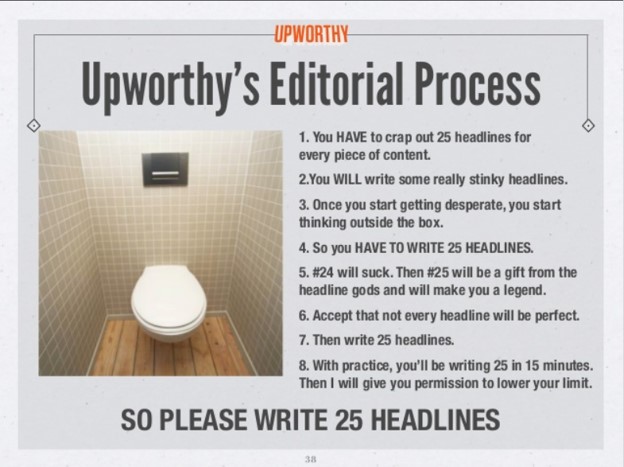 The main takeaway for writing headlines is repetition is key. Upworthy’s writers create 25 title options for each blog. That’s probably more options than you’ll need, but coming up with several options for each post is definitely a worthwhile exercise.
The main takeaway for writing headlines is repetition is key. Upworthy’s writers create 25 title options for each blog. That’s probably more options than you’ll need, but coming up with several options for each post is definitely a worthwhile exercise.
No. 3: Optimize blog titles for search engines
As you build out your list of title options, you’ll want to include the specific words and phrases your audiences are searching for related to the topic. Incorporating the specific words and phrases (i.e., keywords) people use to find content about your topic allows you to optimize your title for search engine results.
To find keywords for your title, head to Google’s Keyword Planner (or a similar tool) and enter phrases related to your topic. The Keyword Planner will then provide the average monthly search volume for each phrase, along with a list of keyword ideas for you to choose from.
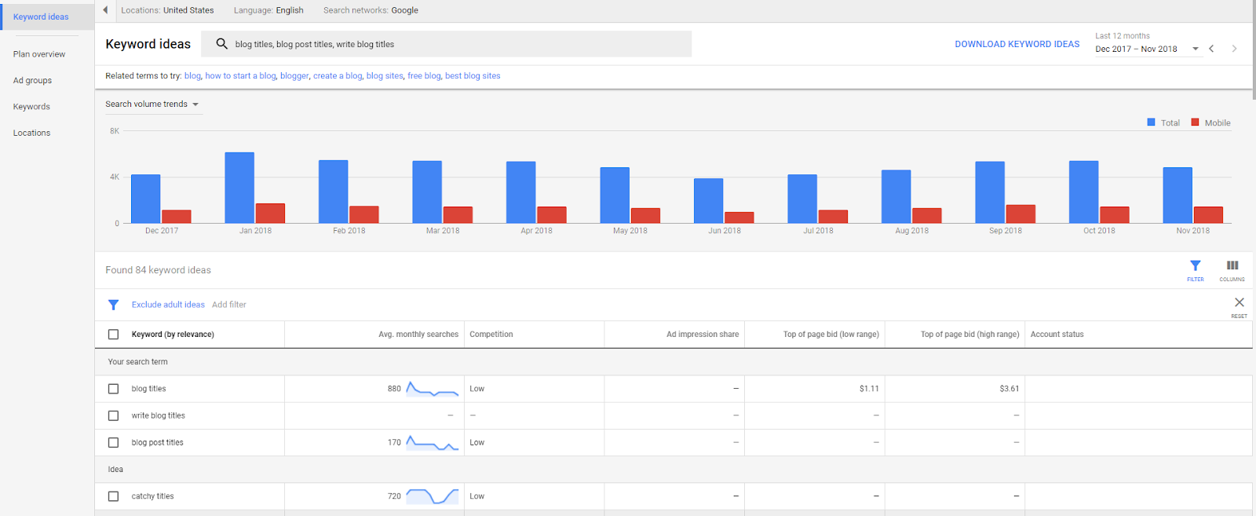
Choose a keyword that has decent monthly search volume and can be naturally woven into your title. For maximum SEO value, try to place your focus keyword toward the front of the title and incorporate it throughout your post.
No. 4: Include words that capture readers’ attention
As you refine your blog title, incorporate words that stand out in search results and social media feeds, pique readers’ interest and inspire them to click through to your post.
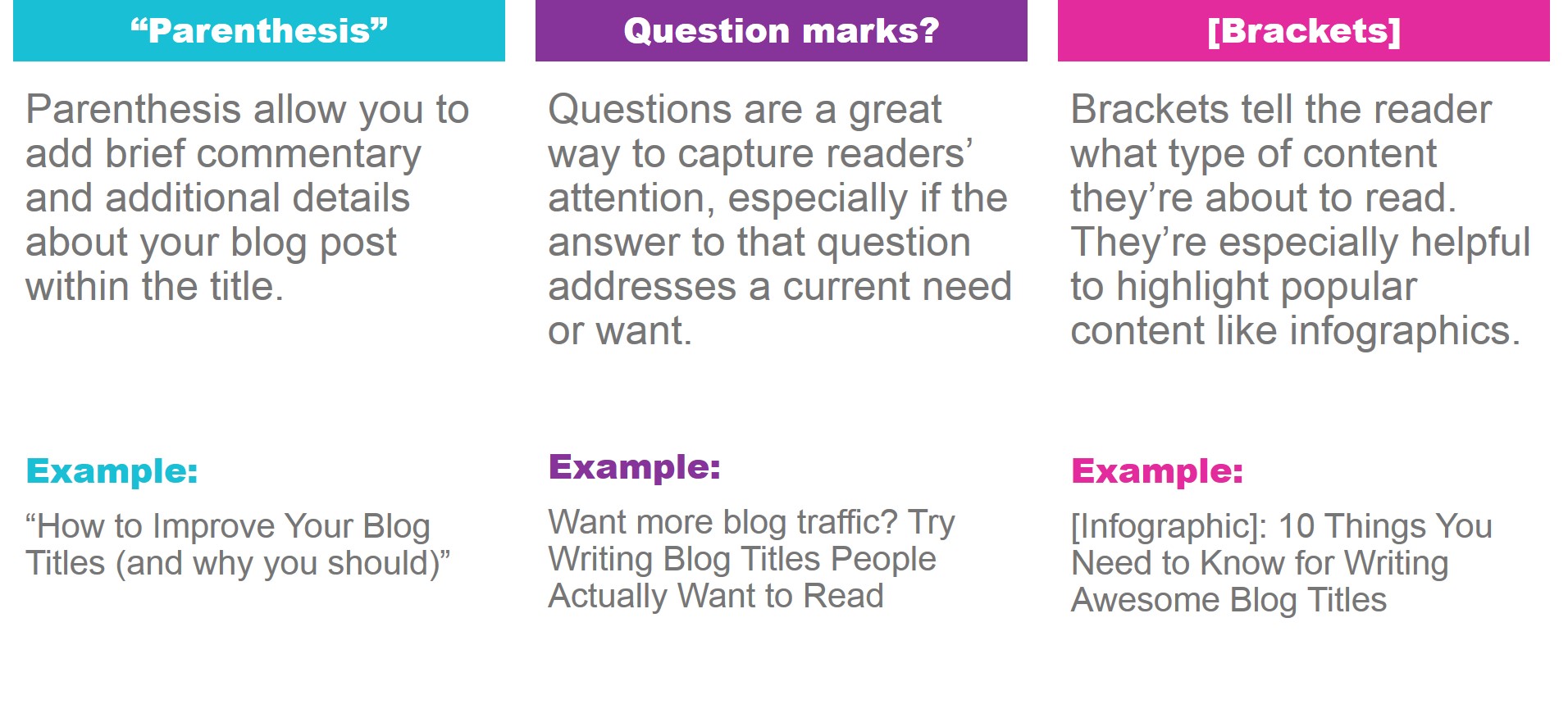
No. 5: Write for your target audience
The types of words in the last tip are all meant to generate a response from your audience. To make sure your blog titles inspire the right response from the right people, imagine you’re talking directly to a member of your audience as you write out your list of options.
- Focus on their interests, needs and wants
- Encourage them to take specific actions to address their needs and wants
- Explain why reading your blog post would be valuable to them
No. 6: Include punctuation
Adding punctuation to your blog titles can be an effective way to grab readers’ attention while providing additional detail on the topic. Not every blog title warrants punctuation, but here are a few effective ways to incorporate marks into your headlines:
No. 7: Add numbers
Structuring your blog post as a list will not only make it easy to write a solid title, this format is also ideal for how online readers typically consume online content. Readers can easily jump into a list, scan the piece for any points that seem appealing or relevant to them and move on.
Average social shares by content type
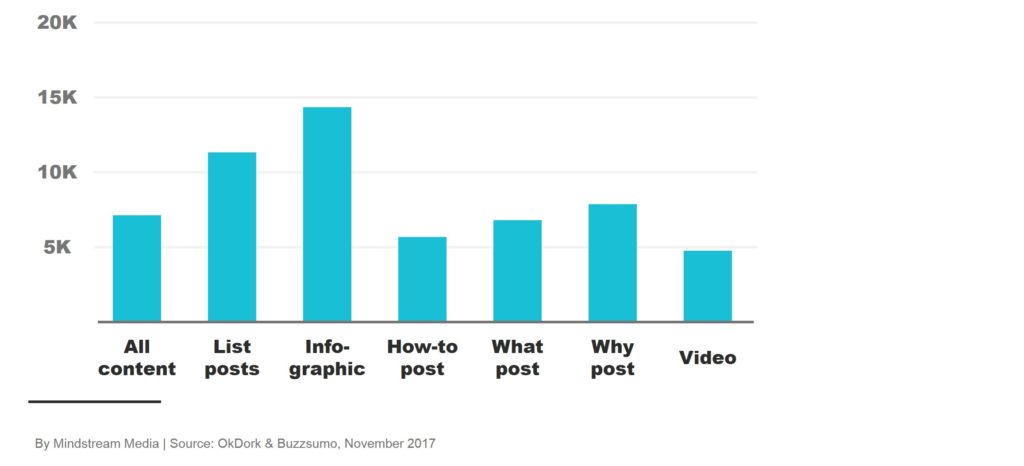
No. 8: Test going negative
While I don’t recommend doing this all the time, using negative headlines can be an effective way to capture readers’ attention. When done correctly, negative headlines should evoke a little consternation from your audience that they might be doing something wrong. Don’t go too overboard though or you’ll fall into the trap mentioned in our next tip.

No. 9: Avoid click-bait headlines
“A consumer is not a moron. She’s your wife. Don’t insult her intelligence, and don’t shock her.”
David Ogilvy
This quote from copywriting legend David Ogilvy may be more than half a century old and the terminology a bit archaic but the lesson behind it is still valuable: don’t try to mislead or trick your audiences. At best, deceptive blog titles (i.e., click-bait headlines) oversimplify and overpromise; at worst, they insult readers’ intelligence.
Unfortunately, click-bait headlines are effective at driving traffic so many publishers use them regularly. While this tactic might work for publishers who are just trying to drive as much traffic as possible to boost ad revenue, it’s less effective for brands. As a brand marketer, your goal should be to write blog titles that attract quality visitors who find your content helpful, engage with your brand and convert into customers.
No. 10: Use tools to perfect your blog title
Once you have a list of title options, there are tools you can use to further optimize the title. For example, CoSchedule’s headline analyzer tool will score your title based on its overall structure, grammar and readability. The tool will also help you identify ways to improve the title like adding more uncommon, emotional or power words.
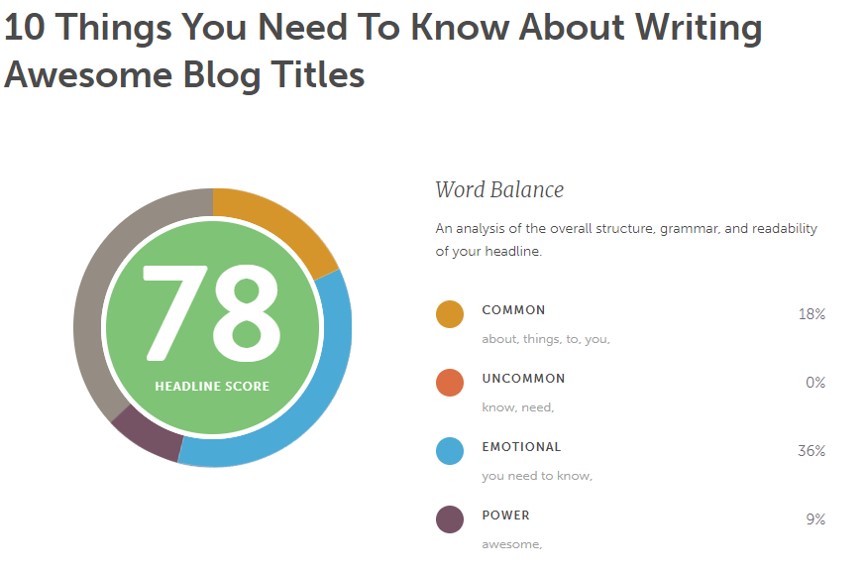
Related – 10 of the Best Free Tools to Help You Produce Killer Online Content

Contact Mindstream Media Group today to learn about our Content Marketing solution!
More from Mindstream Media Group

Meet the Mindstreamer – Chandler Swanner
Chandler Swanner’s interest in advertising dates back to her childhood. Her mother (and role model in life) was a Media […]

Third-Party Cookie Phase-Out: What Marketers Need to Know
Cookies are an essential part of internet usage, allowing websites to remember you and provide a more personalized experience. This […]

Meet the Mindstreamer – Kaya Bucarile
She plans and oversees media strategy for agency clients, working closely with project and platform managers to ensure that we […]
